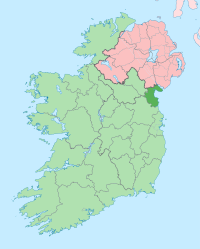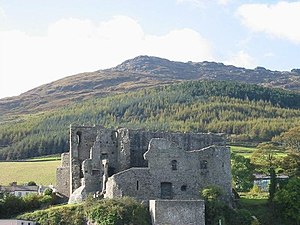
County Louth (Contae Lú) is in the East Coast and Midlands region of Ireland, and traditionally part of the province of Leinster. It's low-lying, fertile and within an hour's travel of Dublin, so it's densely populated, with Dundalk and Drogheda the main towns.
Towns
[edit]- 1 Dundalk, the county town, is near several prehistoric sites, and is the base for exploring Cooley Peninsula.
- 2 Carlingford is a resort village with a medieval castle, abbey and town gate.
- 3 Louth gives its name to the county but is a tiny village. St Mochta's House is a reconstructed medieval oratory.
- 4 Clogherhead is a small fishing village and beach resort.
- 5 Drogheda has medieval fortifications and a fine church, with monastic ruins nearby at Mellifont and Monasterboice.
Other destinations
[edit]- 1 Brú Na Bóinne Archaeological Park is just across the boundary into County Meath, but is easily accessed from Drogheda. It's an amazing complex of Neolithic burial and ritual sites.
- The Battle of Boyne was likewise fought across the county boundary just outside Drogheda.
Understand
[edit]- But I who have written this story, or rather this fable, give no credence to the various incidents related in it . . . - coda to the legend of Cú Chulainn
County Louth is a fertile lowland in Leinster, bordered to its east by the Irish Sea and to its north by the brooding mountains of Ulster. So it's always been on the frontier of the badlands, and Irish legends thunder with the stories of its supernatural and superhuman conflicts. Louth itself is named after Lugh, a multi-talented warrior god who devised a Gaelic precursor to chess. One major legend-cycle, Táin Bó Cúailnge or "The Cooley Cattle Raid", may have been written down as early as the 8th century AD. Its ostensible MacGuffin is ownership of a prize bull, but it's really about the struggle between Ulster and other regional rulers, notably Queen Medh or Maeve of Connacht. An ancestral curse renders the Ulstermen too weak to fight, except for the teenage hero Cú Chulainn, son of Lugh, who in episode after episode defeats the invaders-cum-rustlers.
The terrain made this an easy place to reach by sea, and worth grabbing - the first well-documented invaders being the Vikings. But it was the 12th century Normans who really stamped their mark on it, with their castles, city walls and monastic foundations, and establishment of a county structure close to the modern pattern. The Tudors consolidated the castles, walls and counties while destroying the monasteries with the Dissolution and Reformation. Several battles were fought around Louth that were extensions of wars in Great Britain. In the 14th century Robert Bruce trounced the English at Bannockburn and became king of Scotland: his brother Edward thought to get in on the fun and got himself crowned High King of Ireland, but 3 years later was defeated and killed near Dundalk. In the 17th century Oliver Cromwell, having beheaded the king of England, opened his campaign in Ireland with a notorious massacre at Drogheda. And late in that century King James II / VII, deposed in England, made Ireland his platform for regaining his throne. His forces faced off against those of King William III across the River Boyne a few km upstream from Drogheda. A defeated James fled into exile, while William advanced to Dublin and ensured Protestant minority rule throughout Ireland.
Thereafter came two mostly peaceful centuries in which Drogheda and Dundalk became large industrial towns, blunting the impact of the famine years, and creating their present layout. The county's long sandy beaches became resorts, and golf clubs were the new cash crop in the fields. Partition of Ireland and the late 20th century "Troubles" cast a pall over Dundalk, but the bigger problem was the twilight of traditional industries and lack of new growth. County Louth has revived somewhat in the 21st century as the commuter belt for thriving Dublin.
Get in
[edit]
By air
[edit]Dublin (DUB IATA) is the best option for its wide range of budget flights, and proximity, with buses direct to Drogheda and motorway links north.
The two Belfast airports are little over an hour's drive to Dundalk.
By boat
[edit]Dundalk no longer has passenger ferries. Belfast, Dublin and Rosslare have ferries from Great Britain and the Isle of Man, and good onward transport.
In summer a car ferry crosses the outlet of Carlingford Lough, connecting Greenore with Greencastle in County Down. So it's a shortcut to the scenic Mourne Mountains.
By train
[edit]Commuter trains run every 30 min from Dublin Connolly to Drogheda. Every couple of hours, the Enterprise Train links Dublin, Drogheda, Dundalk, Newry, Portadown and Belfast Lanyon Place.
Dublin Connolly also has commuter trains from around the city, inter-city trains to Wicklow, Arklow, Wexford and Rosslare (for ferries to Wales), and inter-city trains to Mullingar, Longford, Boyle and Sligo. In Dublin allow 45 min to change stations for trains from Cork, Limerick and Galway, which run to Dublin Heuston.
By bus
[edit]Buses from Dublin run via the airport (which doesn't have a railway link) to Drogheda. Inter-city buses from the north don't stop in the county, so from Belfast take the train. There are cross-border buses between Newry and Dundalk but they're slow and roundabout.
By road
[edit]M1 from Dublin to Belfast traverses the county. Get off at Exits 7, 8, 9 and 10 for Drogheda, and Exits 16, 17 and 18 for Dundalk. There's a toll between Exits 7 and 8.
Get around
[edit]- Most of the county is on the Dublin - Drogheda - Dundalk - Belfast transport spine, with trains and buses. There are local buses to most outlying visitor attractions, including Brú na Bóinne, Collon, Monasterboice, Clogherhead, Louth village, Dromiskin and Carlingford. Areas around the edge of the county have a sparse service.
- You don't need a car within the towns, but they're not congested (except the daily rush to and from Dublin, or its Park & Rides) and parking isn't difficult. You need your own wheels for Cooley Peninsula, Castle Roche, and the coast around Clogherhead. Distances and gradients aren't great so a bike will do.
See
[edit]
- Cooley Peninsula is the most scenic part of the county, with Slieve Foy its highest point.
- Prehistoric sites: Brú na Bóinne is impressive but very touristy. Escape to Proleek Dolmen and Clochafarmore near Dundalk.
- Ruined abbeys: Mellifont and Monasterboice are within 10 km of Drogheda, and Dromiskin and St Mochta's are south of Dundalk.
Do
[edit]- What's on? See Drogheda#Do and Dundalk#Do, Louth doesn't have county-wide listings.
- Beaches: long sandy beaches line the Louth coast. Just south of Drogheda, Bettystown beach hosts the National Sandcastle and Sand-Sculpting Competition in late June. North of the Boyne estuary, beaches run from Baltray to Clogherhead then almost all the way to Dundalk.
- Sailing: Carlingford and Drogheda have recreational marinas. Clogherhead is mainly a fishing port but visitor boats can launch.
- Golf: lots of courses, the main concentration is around Drogheda.
- Drive a tank: the Irish Military War Museum is at Collon north of Drogheda. You can just turn up to view, but must book to drive.
- Watch Gaelic games: the County GAA play Gaelic football and hurling in Drogheda. There are about 40 club teams across the county.
- Look up your Irish ancestors: the county archives and library are in Dundalk, with a list of helpful source documents. One fellow who's already traced his kin is Joe Biden, President of the United States from 2021. His great-grandfather Joe Finnegan as a child emigrated from Louth to the US in 1850. All Biden's maternal great-great-grandparents were born in Ireland (mostly in County Mayo) and he reckons to be 5/8 parts Irish.
- Féile na Tána is a festival and masterclass in Irish trad music, song and dance, held in Carlingford in early February.
Eat
[edit]
- Eastern Seaboard in Drogheda, and Collon House Hotel north of town, get rave reviews.
- Fish straight off the boat at Port Oriel harbour in Clogherhead. But it's a fishmonger not a fish & chips takeaway, you'll have to cook them yourself.
- Potatoes out of a potato-vending machine near Clogherhead. How come this wasn't invented sooner? - it would have totally altered Irish history.
Drink
[edit]- You will seldom be far from a pub in Drogheda, Dundalk, or the resort villages of Carlingford and Clogherhead.
- In Drogheda you have to try The Mariner for its sea-faring decor.
- Spirit Store in Dundalk sounds like a wine shop, but it's a big bar and entertainment venue by the harbour.
- The county's good agriculture, transport and thirsty workforce meant that brewing and distilling were major industries here. Many have succumbed to the multinationals, but there are several small independent breweries and distilleries around Drogheda and Dundalk, and tours may be available.
Go next
[edit]- The County Dublin coast is worth exploring on the way to the city: Balbriggan, Skerries, Malahide and Howth.
- Inland, there's lots more to County Meath beyond Brú na Bóinne, such as Loughcrew Cairns near Oldcastle.
- The Mourne Mountains rise just north of the border. On the way to Belfast, take in the historic Ulster towns of Newry, Banbridge and Lisburn.


